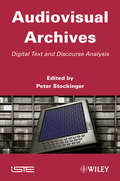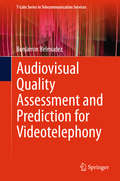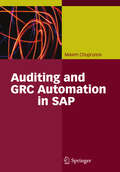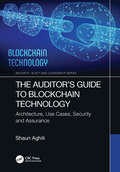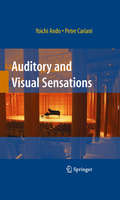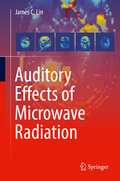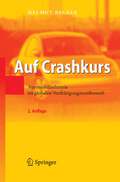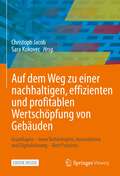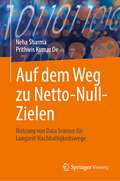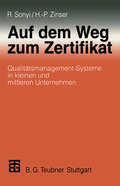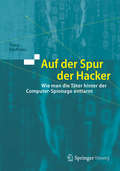- Table View
- List View
Audiovisual Archives: Digital Text and Discourse Analysis
by Peter StockingerToday, audiovisual archives and libraries have become very popular especially in the field of collecting, preserving and transmitting cultural heritage. However, the data in these archives or libraries - videos, images, soundtracks, etc. - constitute as such only potential cognitive resources for a given public (or “target community”). One of the most crucial issues of digital audiovisual libraries is indeed to enable users to actively appropriate audiovisual resources for their own concern (in research, education or any other professional or non-professional context). This means, an adaptation of the audiovisual data to the specific needs of a user or user group can be represented by small and closed "communities" as well as by networks of open communities around the globe. "Active appropriation" is, basically speaking, the use of existing digital audiovisual resources by users or user communities according to their expectations, needs, interests or desires. This process presupposes: 1) the definition and development of models or "scenarios" of cognitive processing of videos by the user; 2) the availability of tools necessary for defining, developing, reusing and sharing meta-linguistic resources such as thesauruses, ontologies or description models by users or user communities. Both aspects are central to the so-called semiotic turn in dealing with digital (audiovisual) texts, corpora of texts or again entire (audiovisual) archives and libraries. They demonstrate practically and theoretically the well-known “from data to metadata” or “from (simple) information to (relevant) knowledge” problem, which obviously directly influences the effective use, social impact and relevancy, and therefore also the future, of digital knowledge archives. This book offers a systematic, comprehensive approach to these questions from a theoretical as well as practical point of view. Contents Part 1. The Practical, Technical and Theoretical Context 1. Analysis of an Audiovisual Resource. 2. The Audiovisual Semiotic Workshop (ASW) Studio – A Brief Presentation. 3. A Concrete Example of a Model for Describing Audiovisual Content. 4. Model of Description and Task of Analysis. Part 2. Tasks in Analyzing an Audiovisual Corpus 5. The Analytical Task of “Describing the Knowledge Object”. 6. The Analytical Task of “Contextualizing the Domain of Knowledge”. 7. The Analytical Task of “Analyzing the Discourse Production around a Subject”. Part 3. Procedures of Description 8. Definition of the Domain of Knowledge and Configuration of the Topical Structure. 9. The Procedure of Free Description of an Audiovisual Corpus. 10. The Procedure of Controlled Description of an Audiovisual Corpus. Part 4. The ASW System of Metalinguistic Resources 11. An Overview of the ASW Metalinguistic Resources. 12. The Meta-lexicon Representing the ASW Universe of Discourse.
Audiovisual Archives: Digital Text and Discourse Analysis
by Peter StockingerToday, audiovisual archives and libraries have become very popular especially in the field of collecting, preserving and transmitting cultural heritage. However, the data in these archives or libraries - videos, images, soundtracks, etc. - constitute as such only potential cognitive resources for a given public (or “target community”). One of the most crucial issues of digital audiovisual libraries is indeed to enable users to actively appropriate audiovisual resources for their own concern (in research, education or any other professional or non-professional context). This means, an adaptation of the audiovisual data to the specific needs of a user or user group can be represented by small and closed "communities" as well as by networks of open communities around the globe. "Active appropriation" is, basically speaking, the use of existing digital audiovisual resources by users or user communities according to their expectations, needs, interests or desires. This process presupposes: 1) the definition and development of models or "scenarios" of cognitive processing of videos by the user; 2) the availability of tools necessary for defining, developing, reusing and sharing meta-linguistic resources such as thesauruses, ontologies or description models by users or user communities. Both aspects are central to the so-called semiotic turn in dealing with digital (audiovisual) texts, corpora of texts or again entire (audiovisual) archives and libraries. They demonstrate practically and theoretically the well-known “from data to metadata” or “from (simple) information to (relevant) knowledge” problem, which obviously directly influences the effective use, social impact and relevancy, and therefore also the future, of digital knowledge archives. This book offers a systematic, comprehensive approach to these questions from a theoretical as well as practical point of view. Contents Part 1. The Practical, Technical and Theoretical Context 1. Analysis of an Audiovisual Resource. 2. The Audiovisual Semiotic Workshop (ASW) Studio – A Brief Presentation. 3. A Concrete Example of a Model for Describing Audiovisual Content. 4. Model of Description and Task of Analysis. Part 2. Tasks in Analyzing an Audiovisual Corpus 5. The Analytical Task of “Describing the Knowledge Object”. 6. The Analytical Task of “Contextualizing the Domain of Knowledge”. 7. The Analytical Task of “Analyzing the Discourse Production around a Subject”. Part 3. Procedures of Description 8. Definition of the Domain of Knowledge and Configuration of the Topical Structure. 9. The Procedure of Free Description of an Audiovisual Corpus. 10. The Procedure of Controlled Description of an Audiovisual Corpus. Part 4. The ASW System of Metalinguistic Resources 11. An Overview of the ASW Metalinguistic Resources. 12. The Meta-lexicon Representing the ASW Universe of Discourse.
Audiovisual Quality Assessment and Prediction for Videotelephony (T-Labs Series in Telecommunication Services)
by Benjamin BelmudezThe work presented in this book focuses on modeling audiovisual quality as perceived by the users of IP-based solutions for video communication like videotelephony. It also extends the current framework for the parametric prediction of audiovisual call quality. The book addresses several aspects related to the quality perception of entire video calls, namely, the quality estimation of the single audio and video modalities in an interactive context, the audiovisual quality integration of these modalities and the temporal pooling of short sample-based quality scores to account for the perceptual quality impact of time-varying degradations.
Auditing and GRC Automation in SAP
by Maxim ChuprunovOver the last few years, financial statement scandals, cases of fraud and corruption, data protection violations, and other legal violations have led to numerous liability cases, damages claims, and losses of reputation. As a reaction to these developments, several regulations have been issued: Corporate Governance, the Sarbanes-Oxley Act, IFRS, Basel II and III, Solvency II and BilMoG, to name just a few. In this book, compliance is understood as the process, mapped not only in an internal control system, that is intended to guarantee conformity with legal requirements but also with internal policies and enterprise objectives (in particular, efficiency and profitability).The current literature primarily confines itself to mapping controls in SAP ERP and auditing SAP systems. Maxim Chuprunov not only addresses this subject but extends the aim of internal controls from legal compliance to include efficiency and profitability and then well beyond, because a basic understanding of the processes involved in IT-supported compliance management processes are not delivered along with the software. Starting with the requirements for compliance (Part I), he not only answers compliance-relevant questions in the form of an audit guide for an SAP ERP system and in the form of risks and control descriptions (Part II), but also shows how to automate the compliance management process based on SAP GRC (Part III). He thus addresses the current need for solutions for implementing an integrated GRC system in an organization, especially focusing on the continuous control monitoring topics. Maxim Chuprunov mainly targets compliance experts, auditors, SAP project managers and consultants responsible for GRC products as readers for his book. They will find indispensable information for their daily work from the first to the last page. In addition, MBA, management information system students as well as senior managers like CIOs and CFOs will find a wealth of valuable information on compliance in the SAP ERP environment, on GRC in general and its implementation in particular.
The Auditor’s Guide to Blockchain Technology: Architecture, Use Cases, Security and Assurance (Security, Audit and Leadership Series)
by Shaun AghiliThe 21st century has been host to a number of information systems technologies in the areas of science, automotive, aviation and supply chain, among others. But perhaps one of its most disruptive is blockchain technology whose origin dates to only 2008, when an individual (or perhaps a group of individuals) using the pseudonym Satoshi Nakamoto published a white paper entitled Bitcoin: A peer-to-peer electronic cash system in an attempt to address the threat of “double- spending” in digital currency. Today, many top-notch global organizations are already using or planning to use blockchain technology as a secure, robust and cutting-edge technology to better serve customers. The list includes such well-known corporate entities as JP Morgan, Royal Bank of Canada, Bank of America, IBM and Walmart. The tamper-proof attributes of blockchain, leading to immutable sets of transaction records, represent a higher quality of evidence for internal and external auditors. Blockchain technology will impact the performance of the audit engagement due to its attributes, as the technology can seamlessly complement traditional auditing techniques. Furthermore, various fraud schemes related to financial reporting, such as the recording of fictitious revenues, could be avoided or at least greatly mitigated. Frauds related to missing, duplicated and identical invoices can also be greatly curtailed. As a result, the advent of blockchain will enable auditors to reduce substantive testing as inherent and control audit risks will be reduced thereby greatly improving an audit’s detection risk. As such, the continuing use and popularity of blockchain will mean that auditors and information systems security professionals will need to deepen their knowledge of this disruptive technology. If you are looking for a comprehensive study and reference source on blockchain technology, look no further than The Auditor’s Guide to Blockchain Technology: Architecture, Use Cases, Security and Assurance. This title is a must read for all security and assurance professionals and students looking to become more proficient at auditing this new and disruptive technology.
The Auditor’s Guide to Blockchain Technology: Architecture, Use Cases, Security and Assurance (Security, Audit and Leadership Series)
by Shaun AghiliThe 21st century has been host to a number of information systems technologies in the areas of science, automotive, aviation and supply chain, among others. But perhaps one of its most disruptive is blockchain technology whose origin dates to only 2008, when an individual (or perhaps a group of individuals) using the pseudonym Satoshi Nakamoto published a white paper entitled Bitcoin: A peer-to-peer electronic cash system in an attempt to address the threat of “double- spending” in digital currency. Today, many top-notch global organizations are already using or planning to use blockchain technology as a secure, robust and cutting-edge technology to better serve customers. The list includes such well-known corporate entities as JP Morgan, Royal Bank of Canada, Bank of America, IBM and Walmart. The tamper-proof attributes of blockchain, leading to immutable sets of transaction records, represent a higher quality of evidence for internal and external auditors. Blockchain technology will impact the performance of the audit engagement due to its attributes, as the technology can seamlessly complement traditional auditing techniques. Furthermore, various fraud schemes related to financial reporting, such as the recording of fictitious revenues, could be avoided or at least greatly mitigated. Frauds related to missing, duplicated and identical invoices can also be greatly curtailed. As a result, the advent of blockchain will enable auditors to reduce substantive testing as inherent and control audit risks will be reduced thereby greatly improving an audit’s detection risk. As such, the continuing use and popularity of blockchain will mean that auditors and information systems security professionals will need to deepen their knowledge of this disruptive technology. If you are looking for a comprehensive study and reference source on blockchain technology, look no further than The Auditor’s Guide to Blockchain Technology: Architecture, Use Cases, Security and Assurance. This title is a must read for all security and assurance professionals and students looking to become more proficient at auditing this new and disruptive technology.
Auditory and Visual Sensations
by Yoichi AndoAndo establishes a theory of subjective preference of the sound field in a concert hall, based on preference theory with a model of human auditory- brain system. The model uses the autocorrelation function and the interaural crosscorrelation function for signals arriving at two ear entrances and considers the specialization of human cerebral hemispheres. The theory may be applied to describe primary sensations such as pitch or missing fundamental, loudness, timbre, and duration. The theory may also be applied to visual sensations as well as subjective preference of visual environments. Remarkable findings in activities in both auditory-brain and visual-brain systems in relation to subjective preference as a primitive response are described.
Auditory Effects of Microwave Radiation
by James C. LinThis book examines the human auditory effects of exposure to directed beams of high-power microwave pulses, which research results have shown can cause a cascade of health events when aimed at a human subject or the subject’s head. The book details multidisciplinary investigations using physical theories and models, physiological events and phenomena, and computer analysis and simulation. Coverage includes brain anatomy and physiology, dosimetry of microwave power deposition, microwave auditory effect, interaction mechanisms, shock/pressure wave induction, Havana syndrome, and application in microwave thermoacoustic tomography (MTT). The book will be welcomed by scientists, academics, health professionals, government officials, and practicing biomedical engineers as an important contribution to the continuing study of the effects of microwave pulse absorption on humans.
Auditory Interfaces
by Stefania Serafin Bill Buxton Bill Gaver Sara BlyAuditory Interfaces explores how human-computer interactions can be significantly enhanced through the improved use of the audio channel. Providing historical, theoretical and practical perspectives, the book begins with an introductory overview, before presenting cutting-edge research with chapters on embodied music recognition, nonspeech audio, and user interfaces. This book will be of interest to advanced students, researchers and professionals working in a range of fields, from audio sound systems, to human-computer interaction and computer science.
Auditory Interfaces
by Stefania Serafin Bill Buxton Bill Gaver Sara BlyAuditory Interfaces explores how human-computer interactions can be significantly enhanced through the improved use of the audio channel. Providing historical, theoretical and practical perspectives, the book begins with an introductory overview, before presenting cutting-edge research with chapters on embodied music recognition, nonspeech audio, and user interfaces. This book will be of interest to advanced students, researchers and professionals working in a range of fields, from audio sound systems, to human-computer interaction and computer science.
Auditory User Interfaces: Toward the Speaking Computer
by T.V. RamanAuditory User Interfaces: Toward the Speaking Computer describes a speech-enabling approach that separates computation from the user interface and integrates speech into the human-computer interaction. The Auditory User Interface (AUI) works directly with the computational core of the application, the same as the Graphical User Interface. The author's approach is implemented in two large systems, ASTER - a computing system that produces high-quality interactive aural renderings of electronic documents - and Emacspeak - a fully-fledged speech interface to workstations, including fluent spoken access to the World Wide Web and many desktop applications. Using this approach, developers can design new high-quality AUIs. Auditory interfaces are presented using concrete examples that have been implemented on an electronic desktop. This aural desktop system enables applications to produce auditory output using the same information used for conventional visual output. Auditory User Interfaces: Toward the Speaking Computer is for the electrical and computer engineering professional in the field of computer/human interface design. It will also be of interest to academic and industrial researchers, and engineers designing and implementing computer systems that speak. Communication devices such as hand-held computers, smart telephones, talking web browsers, and others will need to incorporate speech-enabling interfaces to be effective.
Auf Crashkurs: Automobilindustrie im globalen Verdrängungswettbewerb
by Helmut BeckerDie Automobilmärkte der Welt (Triade) sind gesättigt. Neue Wachstumsmärkte wie Asien und Osteuropa können die fehlende Nachfrage nicht ausgleichen. Die globale Krise verursacht einen Verdrängungswettbewerb, der sich durch aggressive Rabattschlachten bemerkbar macht. Die Folgen: sinkende Erträge, Arbeitsplatzabbau, Produktionsverlagerung in Niedriglohnländer. In diesem Buch: die fundierte Prognose über die Zukunftsfähigkeit der elf verbliebenen Volumenhersteller (IWK-Survival-Index) und damit der gesamten Branche. Wie entwickelt sich der Markt in den nächsten zehn Jahren? Wer überlebt, wer scheidet aus? Wird Deutschland Automobilstandort bleiben?
Auf dem Weg zu einer nachhaltigen, effizienten und profitablen Wertschöpfung von Gebäuden: Grundlagen – neue Technologien, Innovationen und Digitalisierung – Best Practices
by Christoph Jacob Sara KukovecBei vielen Fragen rund um nachhaltige Profitabilität- und Produktivitätssteigerungen der Bau- und Immobilienwirtschaft unterstützt dieses Werk die Leser*innen, durch Einsatz digitaler Tools und Innovationen, die Dynamik der gesamten Prozesse deutlich zu verbessern. Dieses Buch hilft die möglichen Potentiale aktiv zu nutzen, um nachhaltig zu handeln, Kosten zu reduzieren und Unternehmen/Bereiche/Abteilungen in eine sichere profitable Zukunft zu führen.
Auf dem Weg zu Netto-Null-Zielen: Nutzung von Data Science für Langzeit-Nachhaltigkeitswege
by Neha Sharma Prithwis Kumar DeDieses Buch diskutiert die Verwendung von Technologie, Data Science und Open Data, um das Netto-Null-Emissionsziel des Pariser Abkommens zum Klimawandel zu erreichen. Es gibt viele Diskussionen über Nachhaltigkeit und Lösungen für den Klimawandel, um die negativen Auswirkungen zu mildern. Die Verwendung von Technologiehebeln zur Bewältigung von Klimaherausforderungen wird jedoch selten als der bedeutendste Katalysator betrachtet. Die verfügbare Forschung in diesem Bereich ist im Allgemeinen qualitativer Natur, bei der Technologie und Daten noch nicht genutzt wurden. Durch den Einsatz von KI/ML sagt das Buch die Klimawandelfolgen aufgrund von Investitionen in den fossilen Brennstoffsektor voraus, schätzt die CO2-Emissionen des Verkehrssektors, prognostiziert die durch nicht erneuerbare Energiequellen verursachte durchschnittliche Landtemperatur und segmentiert indische Bundesstaaten auf der Grundlage von Haushalts-CO2-Emissionen. Die Forscher, Entscheidungsträger, Studenten, Lehrer, Bildungseinrichtungen, Regierungen, Regulierungsbehörden, Unternehmen, internationale Organisationen usw. werden immens von diesem Buch profitieren. Darüber hinaus soll dieses Buch dazu dienen, den nächsten Generationen eine dekarbonisierte Umgebung und eine bessere Zukunft zu bieten.
Auf dem Weg zum Nullemissionsgebäude: Grundlagen, Lösungsansätze, Beispiele
by Manfred SchmidtEnergie erzeugende Gebäude erzeugen die zu ihrem Betrieb benötigte Energie zum Teil oder gänzlich selbst. Um die dafür benötigte Energie zu quantifizieren, werden die nötigen Bedingungen für das Raumklima und den Gebäudeerhalt und der sich daraus ergebende Energiebedarf für Gebäude dargestellt. Die Anlagen zur Gebäudeenrgieversorgung und die Strategien ihrer Bemessung werden erläutert. Wegen des stochastischen Charakters der zur Energieversorgung bereit stehenden Energien wird auf die Rolle von Energiespeichern, den Speichermedien und deren Rückwirkung auf die Gebäudegestaltung einzugehen. Die Klassifikation von Niedrig- bzw. Nullemissionshäusern, relevante Beispiele und deren betriebswirtschaftliche Bewertung schließen das Buch ab.
Auf dem Weg zum Zertifikat: Qualitätsmanagement-Systeme in kleinen und mittleren Unternehmen
by Richard Sonyi Hans-Peter ZinserZum beherrschenden Thema in den Unternehmen der gewerblichen Wirtschaft ist seit der Qualitätsinitiative im Jahre 1989 die Einführung eines Qualitätsmanagement Systems geworden. Das gilt ebenso für den formalen Nachweis dieses Systems, d.h. die Zertifizierung. Im internationalen Vergleich besteht Nachholbedarf. Einige Länder, vor allem Großbritannien, haben die für die Einführung von Qualitätsmanagement-Systemen zuständige Normenreihe DIN EN ISO 9000 schon viel früher konsequent angewandt. In Deutschland nimmt das Bewußtsein für die Bedeutung des Qualitätsmanagement Systems deutlich zu. Gestiegener Marktdruck und Strukturwandel, dem die meisten Unternehmen unterliegen, sind Gründe dafür. Der gestiegene Marktdruck zeigt sich vor allem in den gestiegenen Kundenforderungen hinsichtlich eines zertifizierten Qualitätsmanagement-Systems. Ein weiterer Grund zur Zertifizierung ist oftmals auch der von einer Zertifizierung betroffene Umsatz, der zeigt, daß die Bedeutung der Zertifizierung immer größere Bereiche eines Unternehmens betrifft. Auch die Bedeutung der einzelnen Nachweisstufen der DIN EN ISO 9000 ff. hat sich in den letzten Jahren stark verändert. Am meisten wird von den Kunden die umfangreichste Nachweisstufe, DIN EN ISO 9001, verlangt. Die Bedeutung der weniger umfangreichen Nachweisstufen DIN EN ISO 9002 und DIN EN ISO 9003 ist merklich geringer geworden. Trotz steigendem Marktdruck verringert sich die Unsicherheit der Unternehmen kaum. Warum ein Kunde ein Zertifikat verlangt, scheint vielen Unternehmen heute noch unklar zu sein. Vielerorts weiß man nicht, ob ein deutsches Zertifikat überhaupt anerkannt wird. Auch können viele Unternehmen kaum einschätzen, ob der Kunde trotz Zertifizierung selbst noch nachprüft.
Auf der Höhe der Zeit: 70 Jahre Industrieverband Klebstoffe e. V.
by Industrieverband Klebstoffe e. V.Diese Festschrift zum 70jährigen Bestehen des Industrieverbandes Klebstoffe e.V. schildert die Entwicklung eines wichtigen, zukunftsweisenden Branchenverbandes im wirtschafts-, politik-, gesellschaftsgeschichtlichen Kontext. Die gestaltende, aktive Rolle des Verbandes in einem von technischem Fortschritt, europäischer Integration, wachsendem Umweltbewusstsein und dynamischer Globalisierung geprägten Markt wird klar herausgearbeitet und dargestellt.Die Klebtechnik gilt unbestritten als die Schlüsseltechnologie des 21. Jahrhunderts. Der deutschen Klebstoffindustrie kommt dabei eine ganz besondere Bedeutung zu. Sie gilt sowohl im europäischen als auch im globalen Wettbewerbsumfeld als Technologieführer.
Auf der Spur der Hacker: Wie man die Täter hinter der Computer-Spionage enttarnt
by Timo SteffensProfessionelle Hackerangriffe (sogenannte Advanced Persistent Threats) treffen heutzutage Regierungen, Unternehmen und sogar kritische Infrastrukturen wie Flughäfen oder Stromnetzbetreiber. Herauszufinden, welche Täter und Auftraggeber dahinter stecken, wird zunehmend wichtiger. Wenn man die Ursprünge eines Angriffs und seine Motive kennt, kann man sich besser schützen und die Konsequenzen eines Datendiebstahls effektiver begrenzen.Damit die Frage, ob ein Angriff aus Russland, China, einem anderen Land, oder von gewöhnlichen Kriminellen durchgeführt wurde, nicht eine Frage des Glaubens oder Bauchgefühls bleibt, soll dieses Buch einen Blick hinter die Kulissen der Ermittler und Analysten werfen. Ausführlich erläutert der Autor die IT-technischen Methoden, mit denen man den Tätern auf die Spur kommt, aber auch, wo diese Methoden an Grenzen stoßen. Zahlreiche Beispiele von aufwändigen Angriffen der letzten Jahre zeigen, wie die Täter falsche Fährten legen, oft genug aber auch Fehler machen, die sie überführen.So bietet der Autor, der seit mehreren Jahren gezielte Hackerangriffe von Spionagegruppen auf Behörden und Unternehmen untersucht, einen spannenden Blick hinter die Kulissen der Ermittler und Analysten. Neben Sicherheitsexperten staatlicher Behörden, Unternehmen, Stiftungen und NGOs, die regelmäßig zum Ziel von Cyberkriminalität werden, finden auch technische Journalisten und interessierte Laien in diesem Buch eine Fülle an Hintergrundwissen zur IT-Forensik.
Aufarbeitung von Kupferendelektrolyten durch Dialyse und Elektrodialyse (Forschungsberichte des Landes Nordrhein-Westfalen)
by Helmut WinterhagerAufbau betrieblicher Informationssysteme: mittels pseudo-objektorientierter, konzeptioneller Datenmodellierung (XLeitfäden der Informatik)
by Max VetterIn diesem Buch wird für Analytiker, Designer von Informationssystemen, Systemkonstrukteure, Datenadmininstratoren, Datenbankadministratoren, Projektleiter sowie Studenten entsprechender Fachrichtungen ein praxiserprobtes, pseudo-objekt- und datenorientiertes Entwurfsprozedere vorgestellt, das der Schaffung von anwendungsorientieren und/oder globalen (unternehmungsweiten) Informationssystemen dient.
Aufbau betrieblicher Informationssysteme: mittels objektorientierter konzeptioneller Datenmodellierung (XLeitfäden der angewandten Informatik)
by PD Dr. VetterAufbau der Moleküle: Eine einführung (Teubner Studienbücher Chemie)
by Friedrich EngelkeDieses einleitende "Vorwort" ist irreführend: Wie wohl fast immer wird es zuletzt geschrieben und steht dem Buch doch voran. Ich blicke aber eher zurück, und so wäre "Nachwort" besser geeignet. Wie ist es nun, nachdem das Manuskript geschrieben ist? Ich denke, der eine nimmt sich viel in seinem Leben vor, der andere weniger. Als ich mir vornahm, ein Buch über Molekülphysik zu schreiben, dachte ich, es sei möglich. Inzwischen hat sich gezeigt, daß es eine wohl unlösbare Aufgabe ist, zumindest für mich. Ein Kapitel über den Aufbau von Molekülen zu Papier zu bringen, macht keine oder nur wenig Schwierig keiten. Aber eine umfassende Molekülphysik - wem ist das geglückt? Es gibt berühmte Autoren, Herzberg, Townes, Schawlow und Steinfeld seien genannt; ihre Träger haben Gutes über Moleküle, ihren Aufbau, ihre Spektroskopie und Strukturbestimmung zustande gebracht, doch nie umfassende Molekülphysik. Ich habe mich dann auf einen Teil begrenzt, wollte eine gute Einführung in den Aufbau der Moleküle schreiben; eine Einführung und nicht die Einführung; eine gu te Einführung . . . was ist eine gute Einführung? Kann der Autor das überhaupt beurteilen? Während ich schrieb, tat ich sicherlich mein Bestes, und als ich die Mühe hinter mir hatte, versuchte ich, das Resultat einzustufen, fragte meine Kollegen, insbesondere aber meine Studenten und Mitarbeiter. Da klärte sich schon einiges. Aber dann kommt die Zeit, mit ihr neue Forschung, neue Ergebnisse, neue Erkenntnis - und sie ändern so manche Bewertung, zum Wesentlichen und zum Unwesentlichen hin.
